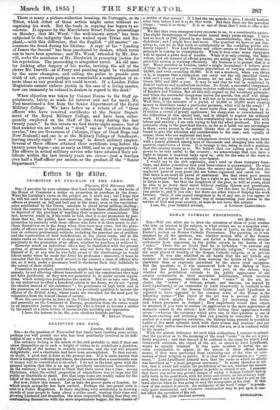ROMAN CATHOLIC PROCESSIONS.
8th March 1855.
Sin—Will you allow me to draw the attention of those of your readers who take an interest in the subject, to what strikes me as a singular over- sight in the debate on Tuesday, in the House of Lords, on the Bishop of Exeter's motion on Roman Catholic Processions. The question, as it was assumed by all the speakers, was, whether section 26th of the Roman Catholic Relief Act does or does not forbid a Roman Catholic secular ecclesiastic from appearing in the public streets in the habits of his " order." There was no doubt that he is forbidden " to exercise any of the rites or ceremonies of the Roman Catholic religion," "save within the usual places of worship of the Roman Catholic religion, or in private houses." It was also admitted on all hands that the act forbids any member of the monastic orders from wearing the habits of his " order" elsewhere than as expressly permitted by the above cited exception. But the question, as it was understood both by the Bishop of Exe- ter and the three Law Lords who took part in the debate, was, whether the prohibition extends to the public appearance of the secular ecclesiastics in their sacerddtal habiliments, which. involves the further question, whether the word " order' in the act, in- cludes the " orders" of bishops, priests, and deacons, (as argued by Lord Lyndhurst,) or (as contended by Lord Cranworth) is confined to the regular " orders" of the Roman Catholic religion. Lord Lyndhurst is reported to have appealed to the common sense of the House in the following terms—"'lie object of the act was to prevent all public displays which might have that effect [of increasing the irrita- tion which prevailed in Ireland.] How imperfectly would that object be attained, if you were to confine its application to the mere appearance of monastic orders in the streets ! how little feeling their appearance would create !—whereas the ceremony which gave rise to this question is one of the most exciting and irritating that can possibly be -conceived. It is de- scribed as a most gorgeous ceremony, the bishops being present in pontifical habits of the most splendid kind, with their mitres and crosiers : and yet you say that such a case does not come within the act, as it is confined solely to the monks."
With the utmost deference for such high authorities, I venture to submit that the question as to the meaning of the word " order " in the act is per- fectly nugatory ; and that though it be confined to the sense for which Lord Cranworth contends, the object of the act, as stated by Lord Lyndhurst, would be equally attained. It was quite needless to forbid the se-
cular ecclesiastics to appear in the streets in their official habili- ments, if they were prevented from exercising any of the rites or cere- monies of their religion in public. It is clear that a procession is a " cere- mony." Lord Lyndhurst himself says, that the scene to which be alludes was described as " a most gorgeous ceremony." It seems therefore to fol- low that it would fall within the prohibition of the act, whether the secular ecclesiastics were permitted to appear in public so attired or not. I presume that there was never any greater danger of seeing a Roman Catholic bishop sally forth in his pontificals, with his mitre and crosier, on busi- ness, than that an Anglican bishop should take it into his heal ordinary to put on his lawn sleeves when he was going to read the newspapers at hie club. is If this view of the subject is correct, the ambiguity of the word "order" practi- cally quite immaterial, and whatever construction may be put upon it can- not affect the operation of the act.
I am, Sir, your obedient servant,
ANGLICAN-II&


























 Previous page
Previous page